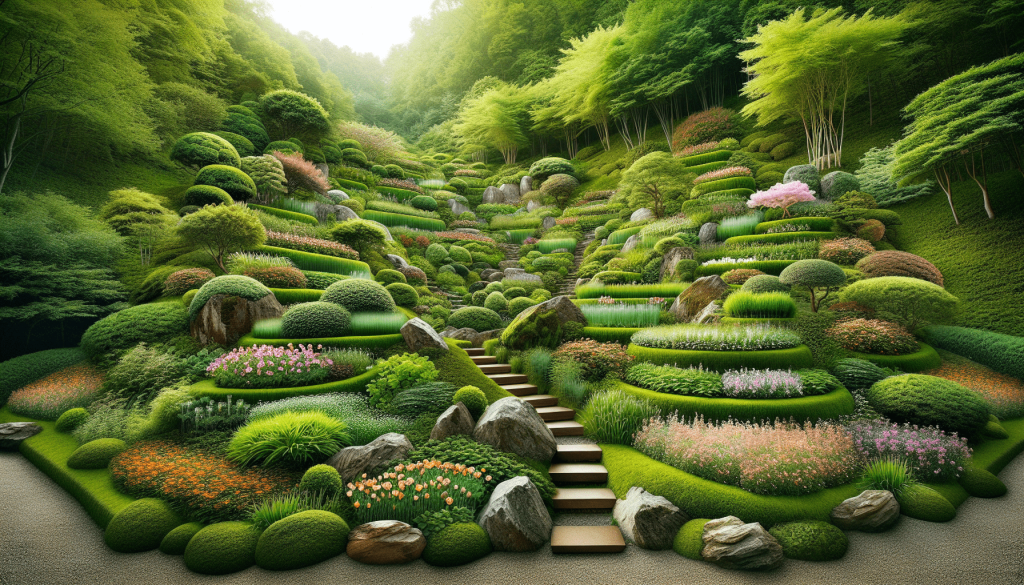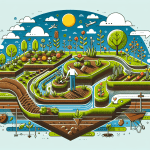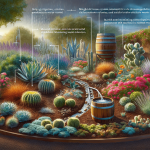This post may contain affiliate links. As an Amazon Associate, we may earn commissions from qualifying purchases.
Have you ever stood at the edge of your sloped backyard, entertained by the thought of creating a picturesque garden, only to be overwhelmed by the prospect of battling soil erosion? Designing a garden that beautifully adorns a slope while mastering the art of erosion reduction can indeed be challenging, but fear not—I’m here to guide you through it with a friendly nudge.
Creating a garden on a slope is like painting a masterpiece on a three-dimensional canvas. The challenges are undeniable: gravity insists on pulling the soil downward, rain showers threaten to wash away your dreams, and you stand there, pondering, “How do I keep it all in place?” But with a little creativity and some clever strategies, you can transform that daunting dilemma into a delightful panorama of vibrant blooms and verdant foliage.
Let’s embark on this journey, step by ever-so-thoughtful step, looking into both the artistry and practicality of curbing erosion while sprouting greenery on your slope.
Understanding Erosion and Its Impact
Before you can effectively combat erosion, it’s crucial to get acquainted with the culprit. What exactly is erosion, and what havoc does it wreak on your sloped garden?
What Is Erosion?
Erosion is nature’s way of redecorating but with little regard for your beautiful plans. It’s the process by which soil is worn away, primarily due to water, wind, or even human activities. On slopes, water becomes the prime suspect, swiftly carrying off the upper layers of soil down to lands unbeknownst, leaving you with a depleted plant palette and bare, unexciting ground.
The Impact on Gardens
When erosion knocks at your garden gate, it doesn’t hold back. It strips away the nutrient-rich topsoil, crucial for plant growth, leaving your flora trying to thrive on skeletal remains of earth. Over time, this process doesn’t just leave your plants struggling—it can lead to issues like gullying and destabilization of your slope. Picture a living area losing its lush appeal and instead resembling a patchy, less-than-appealing terrain.
Planning Your Garden Design
Before the fun part of planting begins, a thoughtful plan must be laid out. The key is to embrace the slope rather than resist it. After all, you and gravity are about to become best friends.
Assess the Slope
Taking a proper look at your slope’s characteristics is the first vital step. What is the angle? Is it steep like a ski slope or gentle enough to meander across with a casual gait? Different angles may require distinct approaches, so get up close and survey the land with a sharp eye. You may even need professional help if it’s more Grand Canyon than gentle hill.
Soil Analysis
Understanding the type of soil that cozily wraps around your incline will provide useful insights. Clay retains water and is prone to compaction; sandy soils drain too quickly, leading to erosion. By identifying the soil type, you can determine what amendments it might need—perhaps a dollop more organic matter for sandy soils or improved drainage for those thick clays.
Here’s a simple breakdown to help identify soil types:
| Soil Type | Characteristics | Erosion Potential |
|---|---|---|
| Clay | Heavy, retains moisture, dense | High |
| Sandy | Gritty, light texture, drains well | Moderate to High |
| Loamy | Balanced, rich in nutrients | Low to Moderate |
Choosing the Right Plants
Your plant selection plays a crucial role in holding the soil together. You’ll want to pick varieties with deep, intertwining roots that grip onto the soil like their lives depend on it—because they do.
Native Plants
Embrace the local flora! Native plants are naturally adapted to your region’s climate and soil conditions, requiring less maintenance while providing a habitat for local wildlife. For instance, in a sunny, arid region, consider drought-tolerant natives like purple coneflower or black-eyed Susan.
Ground Cover
These are your slope’s unsung heroes. They play the role of the protective carpet, spreading their roots wide to interlock with peers, keeping that soil snug and secure. Think creeping thyme, juniper, or vinca minor.
Shrubs and Trees
These go beyond aesthetics. Deep-rooted shrubs and trees act as anchors, weaving roots deep into the earth to stabilize your slope further. Lavender, dwarf pine, or serviceberry can be fantastic options.

Implementing Erosion Control Techniques
Now that your garden is envisioned, let’s explore the strategies to make it all come together, holding its ground against the erosive forces it faces.
Terracing
Transform your slope into a stepped garden of Eden. Terracing divides your slope into a series of flat areas, providing level planting zones to manage the gradient effectively. This not only minimizes erosion but also increases planting space! Use materials like stone, wood, or pre-cast concrete blocks to create these eye-catching terraces.
Building a Retaining Wall
While it sounds intimidating, a retaining wall serves as a courageous guard, halting soil from tumbling downhill. Opt for sturdy materials—stone, brick, or even decorative concrete—and ensure sufficient drainage behind the wall to prevent water pressure from building up.
Creating Diversions
Stop water in its track or guide it in a beneficial direction with diversions like swales or rain gardens. Swales are shallow, vegetated ditches that manage water flow, directing it to areas where it’s less likely to cause harm. Rain gardens act as natural reservoirs, capturing runoff while supporting wetland plants.
Mulching
Mulch isn’t just for aesthetics. A robust layer of mulch, such as wood chips or shredded bark, acts as a protective shield over your soil. It reduces runoff, retains moisture, and slowly breaks down to enrich the soil with organic matter.
Maintenance and Care
Once your garden is in place, keeping up the defense is vital. It’s a war against erosion—regular maintenance can be your strongest ally.
Regular Inspection
Keep an eye on how your plants are doing and what the slope looks like post-storms. Look for signs of erosion such as exposed roots, rills, or small channels, and address them promptly.
Pruning and Weeding
A tidy garden is a happy garden. Regular pruning ensures your plants are growing optimally, while weeding prevents unwanted plants from overtaking your chosen ones.
Seasonal Planting
Consider the changing seasons as opportunities for adding bursts of color or diversifying the root system. Seasonal plants offer flexibility and rejuvenate the landscape rhythmically.
Amending Soil
Feed that slope! Regularly enrich your garden with organic materials like compost or well-rotted manure. This improves soil structure and boosts its ability to retain water, lowering erosion probability.

Conclusion: Your Slope as a Living Canvas
By now, that once-daunting slope may seem more like an opportunity—to craft a verdant escape, an artwork in layers, each slowing rain’s rush and transforming the space into a flourishing habitat. Designing a garden on a slope is a statement of resilience, melding aesthetic allure with environmental consciousness. It’s a dance with nature, where every plant, every terrace, sings in harmony, holding together a narrative of beauty overcoming challenge. Embrace this journey with curiosity and confidence, for your sloped garden is not just an area of land—it is a testament to thoughtful design and the enduring spirit of life.
Remember, as you sip a cool lemonade, admiring the delicate work of art you’ve created, every droplet of thought and effort is a stitch you’ve sewn in the safety net against erosion. Armed with these insights, your landslide of troubles is now a garden of delights, growing steadfastly—one with gravity and you as the artist of this lively masterpiece.








